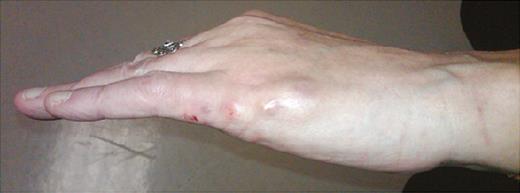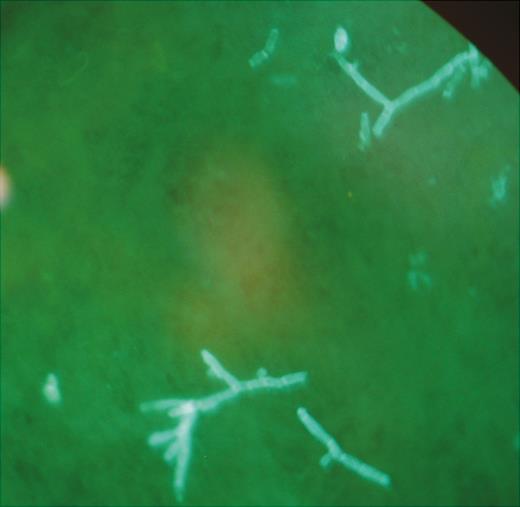-
PDF
- Split View
-
Views
-
Cite
Cite
A Pancreas Transplant Recipient With Cutaneous Lesions After Handling A Rose Bush, Clinical Infectious Diseases, Volume 64, Issue 7, 1 April 2017, Page 971, https://doi.org/10.1093/cid/cix066
Close - Share Icon Share
(See pages 981-2 for the Answer to the Photo Quiz)
A 49-year-old lady from Ohio, United States of America, presented with painless swellings on the medial aspect of her left little finger and the medial edge of her left hand. These swellings had developed 8 months earlier after handling a rose bush in her garden without gloves and had intermittently drained brown material. Aspiration of one of the nodules 2 months before presentation grew Staphylococcus epidermidis that was susceptible in vitro to oxacillin. However, there was no improvement after treatment with oral dicloxacillin. She did not have fever, had not noticed swollen lymph glands, and was overall feeling well. She was right-handed. She did not have a fish tank. She had not sustained bites or scratched from her pet cat. She had not been exposed to any body of water, other than from her home well. She had insulin-dependent diabetes mellitus for which she had undergone pancreas transplant 6 years before presentation. She had been receiving a stable immunosuppressive regimen consisting of prednisone, tacrolimus, and mycophenolate mofetil, with no allograft rejection. She had transient cytomegalovirus viremia 1 year after transplantation. She had been receiving warfarin after undergoing prosthetic aortic valve replacement 1 year before transplantation. On physical examination, she was afebrile and appeared well. Four firm, mobile nodules ranging in size from a few millimeters to 2 centimeters were palpable on the medial aspect of the left little finger and the medial edge of the left hand (Figure 1). Nodules were not tender and with normal overlying skin. Left epitrochlear and axillary lymph nodes were not palpable. Palpating the pancreatic allograft was not tender. Aspirating the largest nodule yielded a small amount of thick, bloody fluid. Fluorescent stain of aspirate showed branching hyphae (Figure 2). She was advised to wear gloves while gardening and was treated with oral itraconazole for suspected sporotrichosis. Tacrolimus level and prothrombin time international normalization ratio were monitored due to anticipated drug interaction with itraconazole. Although she did not have pulmonary symptoms, surveillance chest roentgenogram was done and was normal.

Subcutaneous nodules on the medial aspect of the left little finger and the medial edge of the left hand.

What is your diagnosis?




